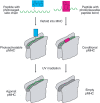Photochemical approaches to T-cell activation
- PMID: 20406301
- PMCID: PMC2878459
- DOI: 10.1111/j.1365-2567.2010.03267.x
Photochemical approaches to T-cell activation
Abstract
Despite decades of intensive research, T-cell activation has remained mysterious because of both the dizzying diversity of antigen recognition and the speed and comprehensiveness of the T-cell-receptor signalling network. Further progress will require new approaches and reagents that provide added levels of control. Photochemistry allows specific biochemical processes to be controlled with light and is well suited to mechanistic studies in complex cellular environments. In recent years, several laboratories have adopted approaches based on photoreactive peptide-major histocompatibility complex reagents in order to study T-cell activation and function with high precision. Here, I review these efforts and outline future directions for this exciting area of research.
Figures



References
-
- Kersh GJ, Kersh EN, Fremont DH, Allen PM. High- and low-potency ligands with similar affinities for the TCR: the importance of kinetics in TCR signaling. Immunity. 1998;9:817–26. - PubMed
-
- Maini MK, Reignat S, Boni C, Ogg GS, King AS, Malacarne F, Webster GJ, Bertoletti A. T cell receptor usage of virus-specific CD8 cells and recognition of viral mutations during acute and persistent hepatitis B virus infection. Eur J Immunol. 2000;30:3067–78. - PubMed
-
- Gavioli R, Guerrini R, Masucci MG, Tomatis R, Traniello S, Marastoni M. High structural side chain specificity required at the second position of immunogenic peptides to obtain stable MHC/peptide complexes. FEBS Lett. 1998;421:95–9. - PubMed
Publication types
MeSH terms
LinkOut - more resources
Full Text Sources
Other Literature Sources

